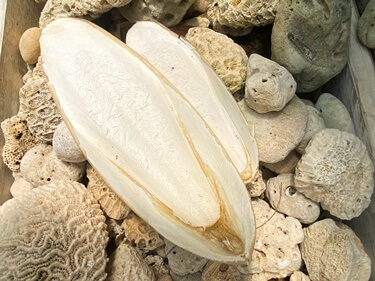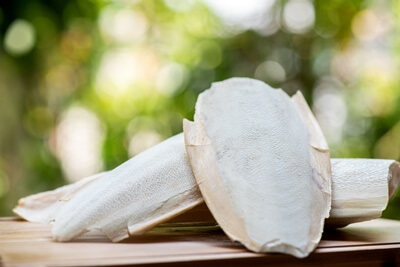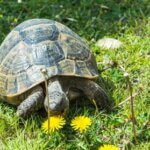Last Updated on October 10, 2023 by Samantha Harris
Cuttlefish bones are among the best sources of dietary calcium for tortoises.
When tortoises are given cuttlebones, they’re less likely to develop shell conditions like soft shell, pyramiding, and shell rot. Also, cuttlefish offer tortoises something abrasive to wear down their beaks.
Tortoises risk developing illnesses like Metabolic Bone Disease (MBD) without enough calcium in their diet. Tortoises also need vitamin D3 from UVB light to absorb the calcium.
What is a Cuttlefish Bone?
Cuttlebones are the internal shells of cuttlefish, which are marine mollusks.
Their unique bone structure helps with buoyancy control. When a cuttlefish dies, its flesh dissolves, but the bones remain, meaning cuttlebones can be found all over the ocean.
Cuttlefish bones are oblong, have a chalky texture, and are white. They comprise 85% calcium carbonate. The rest are minerals like phosphorus, magnesium, and iron.
Cuttlefish bones can be found in the ocean, but you can get them at most pet stores.
They’re a source of calcium for many avian and reptilian pets. Cuttlefish bones must be sanitized before being given to an animal to kill harmful germs and bacteria.
Why Do Tortoises Need Cuttlefish Bones?
Tortoises need calcium in their diet because much of their physiology depends on it, including their:
Bones
Tortoises have intricate skeletal structures and need calcium for strong, healthy bones.
According to the Veterinary Record, tortoises with a consistent amount of calcium and vitamin D3 in their diets grow healthily and sustainably.

What is Metabolic Bone Disease (MBD)?
MBD is an umbrella term for any disease affecting a tortoise’s bones and shell.
According to Zoo and Wildlife Medicine, Metabolic Bone Disease is a common medical disorder in pet tortoises. It includes conditions like Paget’s disease, osteoporosis, and osteomalacia.
Tortoises most at risk of developing MBD are hatchlings and egg-laying females.
Hatchlings grow most during the first few years of their lives. If there isn’t enough calcium and vitamin D3 in their diet, it’ll impact their growth and development.
Egg shells are partially made of keratin and calcium, so an egg-laying female tortoise needs calcium.
Because MBD is so common, you must recognize the signs. Loss of appetite, lethargy, constipation, a deformed shell, and bowed legs are signs a tortoise needs more calcium.
Shells
The top of the tortoise’s shell (carapace) and the bottom (plastron) consist of beta-keratin (β-keratin).
The calcium in a tortoise’s diet affects how thick the keratin is. If the tortoise has a calcium deficiency, its shell won’t grow at the same rate.
A lack of calcium can cause the shell to soften. Because tortoises use their shells for protection, having a soft shell puts them at risk of predation and injury.
Pyramiding, the excessive upward growth of shell scutes, can be caused by calcium deficiency. While the condition can’t be reversed, the proper dietary regimen can prevent it from worsening.
Eggs
Female tortoises lay eggs made of keratin and calcium. Giving a nesting tortoise enough calcium is essential to lay healthy eggs without compromising her health.
Without it, the eggshells will be vulnerable, or egg binding can occur, which is life-threatening.
Beak Overgrowth
Tortoises grind down their beaks when they dig burrows and look for food. Captive tortoises aren’t as active as wild tortoises, so there aren’t as many opportunities to keep their beaks short.
Beak overgrowth is a severe problem for captive tortoises, affecting their ability to eat and perform specific tasks. Give them a cuttlefish bone so they can grind their beaks down.
Can Tortoises Have Too Much Calcium?
Tortoises can ingest excessive calcium, so cuttlefish should only be used as a dietary supplement. Too much calcium can cause deformed shells, but it’s unlikely.
While it’s true that many tortoises can self-regulate their calcium intake, some can’t.
Some species, like sulcata tortoises, are from areas with limited resources. When encountering anything with nutritious value, they gorge on it due to their survival instincts.

How To Feed Cuttlebone to Tortoise
There are several ways you can feed cuttlebone to tortoises. You can do the following:
- Place the entire cuttlefish bone in the enclosure and let the tortoise eat when it chooses.
- Crush it and sprinkle it on top of the food.
- Hand-feed it a portion.
Putting a cuttlefish bone in the enclosure gives tortoises calcium and a way to wear down their beaks. The downside to this is that the tortoise could ingest too much calcium.
Handfeeding a portion of cuttlebone prevents excessive calcium intake. Some tortoises aren’t all that fond of cuttlebone, so crushing and sprinkling it on food can be helpful.
Alternatives To Cuttlebone
Here are some other sources of calcium:
- Calcium powder.
- Mineral blocks.
- Crushed eggshells (not raw).
- Crushed oyster shells.
- Plaster blocks.
- Boiled chicken bones.
- Manu blocks.
These cuttlebone alternatives for tortoises contain a healthy amount of calcium and are safe.
Be wary of cuttlebone alternatives that come in a special shape, color, or flavor because they may be chemically altered or include an unnatural binding agent.
Consuming cuttlebone is an excellent way to top up a tortoise’s calcium levels. However, a tortoise will need vitamin D3 from sunshine or UVB lighting to utilize the calcium.





